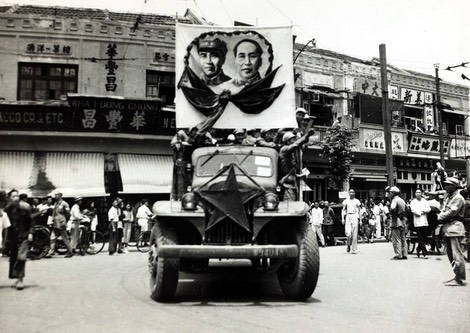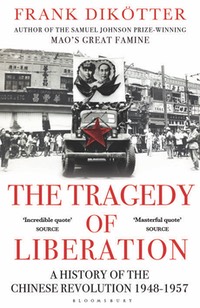The Guardian, 30 August 2013
For years, one of the most powerful accounts of the Chinese revolution in the countryside was the American socialist William Hinton's memoir Fanshen (1966). Hinton used his own observations to assess the social transformation after 1949 as messy and unpredictable, but ultimately positive. Fanshen became a landmark in western understanding of China, inspiring, for example, a play by David Hare.
In recent years, this favourable image of the revolution has come under severe questioning both within China and outside. Frank Dikötter, whose major study of the Great Leap Forward, Mao's Great Famine (2011) won the Samuel Johnson prize, has now written a "prequel" in which he analyses the foundation of the People's Republic of China, from the civil war between the nationalists and communists in 1946-49 to the "anti-rightist" campaign of 1957.
Unlike Mao's Great Famine, this volume is not centred on one major event. However, it has the advantage of enabling Dikötter to turn his lens on a variety of places and people who helped create Mao's China. In doing so, he has written a brilliant and powerful account of the formation of that society. This is an angry book, but its fury is always contained within a framework of impressive research and elegant prose. For Dikötter, the People's Republic did not offer fanshen (emancipation) but rather, echoing Friedrich Hayek, set its people on "the road to serfdom".
For many years, historians tended to argue that the first decade or so of the Chairman's rule was generally benevolent and productive, with the rot setting in during the Great Leap Forward and the Cultural Revolution. Dikötter takes a significantly different stance: the state was from its foundation shaped by violence and used coercion, both psychological and physical, to exert its will on the population. This version of the PRC is not a paradise lost: it was always hell.
One frank admission comes from Deng Xiaoping, already a significant Communist party figure by the 1940s, concerning land reform among the peasant farmers of western Anhui province. "We kept on killing," he declared, "and the masses kept on feeling more and more insecure, taking fright and fleeing." Deng admitted that "all the work we did in twelve villages was ruined". Mass, sometimes public executions, were used to bring the population into line. In six populous central Chinese provinces, some 300,000 people were killed between October 1950 and November 1951.
Not all misery was based in violence. One poignant vignette describes vagrants being forced into re-education through reform: the official report noted that "there are even some small children who cry all the time, begging to be allowed to go home."
Mao himself appears much less than one might expect. Details of his decisions are there, to be sure, but Dikötter's aim is to show that the creation of the terror state was not simply the product of one person's will. (Other recent work on the PRC has also sought to define Mao in this wider context. Mao's Last Revolution, by Roderick MacFarquhar and Michael Schoenhals, shows that the darkness of the Cultural Revolution was created not by Mao alone but with the complicity of his entire leadership, including the "decent" premier Zhou Enlai and the "reformist" Deng Xiaoping.)
The effect is fascinating: it brings to the fore a variety of actors at a local level who sought to implement the dictates of the new state, often without scruple or wisdom. One of the book's many merits is that it gives full weight to the Chinese countryside, drawing on previously closed local archives. The history of China's urban population has attracted more attention over the years, but Dikötter forces the gaze back to China's peasants, who were promised much from the revolution and often betrayed.
While he does an excellent job of showing how the new order gradually took shape, his analysis does leave space for a continuing debate on the reasons for the new regime's stability. Dikötter concentrates on analysing a system that gradually terrorised the population into submission. However, it is not entirely clear why it was possible for the state to implement such a system in the first place. Dai Li, the sadistic security chief of the nationalist regime that preceded Mao, would have loved to have acquired that level of control over the population, but he never achieved it.
Dikötter refers at one point to the groundbreaking work of the historian of the USSR, Sheila Fitzpatrick, whose research on the Stalin era rewrote our understanding of a political paradox: how can a regime simultaneously abuse its population and yet achieve genuine popularity? Part of the answer for China may come from other work that is emerging on the 1950s, which is currently one of the liveliest fields in the academic world of Chinese history. This new work has examined areas such as youth culture and consumerism to show a real enthusiasm for the new regime among many sections of society. Many would become swiftly disillusioned, but their commitment was not feigned.
One suggestion that Dikötter makes is a comparison of Mao's China with the post-1945 Eastern European regimes that appeared genuine but were in fact puppets of Stalin. However, although Stalin was a mentor, as well as a dysfunctional ally for Mao, the PRC was an indigenous Chinese product. Mao's revolution, and its monstrosities, were products of forces that came from within China: social inequality, the war with Japan, and a political culture of violence. Other factors also affected the behaviour of China's leaders, such as the country's relative isolation from the world economy, about which it could do little in the face of American sanctions. None of these factors remotely excuses the horrors that are chronicled meticulously here, but they do provide a context.
However, even if the book is likely to spark debates about the nature of the socio-economic crisis stimulated by the PRC's policies, few will be able to deny the human suffering brought about in the name of the new society and described by the author with brutal clarity. It has often been the contention of those who find democracy messy that dirigiste rule can be an improvement (Hayek, who condemned serfdom of one sort, was quite tolerant of various other forms: he described apartheid as "civilisation of a sort" and argued that a "liberal dictator" was sometimes better than a democracy).
Nobody who reads about the cost of the establishment of the PRC in Dikötter's humane and lucid prose will find much sympathy for the authoritarian case. This excellent book is horrific but essential reading for all who want to understand the darkness that lies at the heart of one of the world's most important revolutions.

